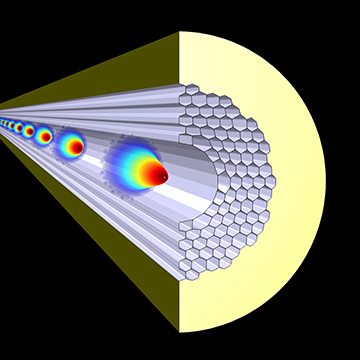
Using a hollow-core photonic bandgap design that balanced thermally induced length changes against temperature-dependent changes in refractive index (and, thus, in light’s group velocity), researchers from the University of Southampton have reportedly fashioned an optical fiber in which light’s propagation time is unaffected by the fiber’s temperature—a first, according to the research team. [Image: Gregory Jasion, University of Southampton]
A team from the University of Southampton’s Optoelectronics Research Centre, U.K., has fashioned an optical fiber in which, according to the researchers, light’s propagation time doesn’t change with temperature variations (Optica, doi: 10.1364/OPTICA.4.000659). The team pulled off the feat through a clever design that precisely offsets the elongation of the fiber at higher temperature with a thermally induced change in the fiber’s refractive index, which boosts the light’s group velocity in the fiber. The result? A fiber with a thermal coefficient of delay (TCD) equal to zero—and a potential benefit to metrology and other applications requiring very precise time signals through fiber.
From glass to air
For every 1°C change in temperature, an optical signal's propagation time through a kilometer of standard solid-core fiber can change by 40 picoseconds. In some areas, such as sensing applications, that kind of temperature sensitivity in fiber is a feature, not a bug. But it can play havoc with a wide range of other fiber applications that rely on precise time signals—things as diverse as tying together optical-clock networks across a continent, synchronizing robotic manufacturing in the Industrial Internet of Things, and using optical-fiber delay lines to stabilize ultraprecise lasers against low-frequency noise.
Fiber researchers have investigated a number of methods to hammer down the temperature sensitivity of fiber propagation time. One method is to apply specialized coatings to the fiber that help offset changes to its refractive index with temperature shifts—the best of which, according to the new study, can reduce the thermal sensitivity of standard telecom fiber to 3.7 ps/km/K.
Another method, previously demonstrated by the same Southampton group responsible for the new Optica study, is to replace solid-core silica glass fiber with a hollow-core photonic bandgap fiber design, in which most of the optical power passes through air rather than glass. Since around 95 percent of the fiber’s propagation-time sensitivity to temperature traces to thermal-optical effects in silica, this change, the group reported, could cut the propagation-time sensitivity to as low as 2 ps/km/K.
Offsetting thermal effects
To get from that from that 2 ps/km/K sensitivity to zero, the Southampton group looked in detail at the parameters that determine the transit time of light within an optical fiber. One, of course, is the fiber’s physical length, which increases with increased temperature. The other is the group-velocity refractive index, ng. And that parameter, the team worked out, can—with the right set of fiber characteristics—be tweaked to decrease with temperature by an amount that offsets the propagation-time increase attributable to the thermally induced elongation of the fiber. (That’s because a decrease in ng causes the light to travel faster in the fiber, all else being equal.)
After analyzing and numerically simulating the details of various coated and uncoated fiber designs, the Southampton scientists, led by OSA Member Eric Numkam Fokoua, fashioned a 2.8-m-long sample of a seven-cell hollow-core photonic bandgap fiber with an air-filling fraction of 96.5 percent, which could operate in the telecom spectral region of approximately 1.55 µm. They then tested the fiber at four temperature settings ranging from 29°C to 82°C.As predicted by the simulations, the fiber had a measured TCD of zero, which meant that the propagation time was completely insensitive to temperature variations—the first such demonstration “to the best of our knowledge,” according to the study.
The researchers suggest that these very low to zero levels of transit-time thermal sensitivity should “bring significant improvement” in the ability to push optical signals through fiber with precise frequency and timing. The result, they believe, represents “the ultimate fiber solution for many propagation time-sensitive applications.”
